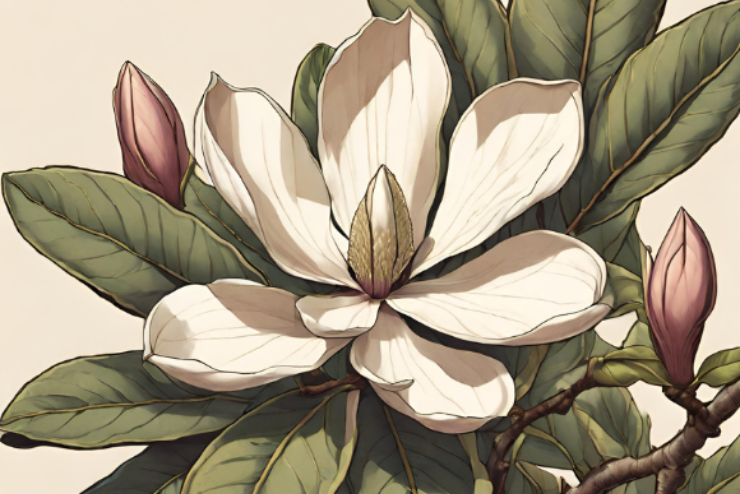
I’ve always been a bit of a rebel in the gardening world. While others fawned over the latest hybrid tea rose or debated the merits of different tomato varieties, I found myself drawn to the unexpected, the overlooked. And let me tell you, friends, there’s nothing more unexpectedly delightful than the Southern Magnolia.
Now, I know what you’re thinking. The Southern Magnolia, with its glossy leaves and giant, fragrant blooms, is hardly overlooked. It’s a staple in many a Southern garden, standing tall and proud like a grande dame at a garden party. But here’s where it gets interesting: this tree isn’t just a feast for the eyes, it’s a feast for the taste buds too!
Yes, you heard that right. The Southern Magnolia, or Magnolia grandiflora if we’re being fancy, is edible. And I’m not talking about surviving-in-the-wilderness edible. I’m talking delicious, versatile, why-haven’t-we-been-doing-this-all-along edible.
Now, before you rush out to your yard and start munching on magnolia petals, let me share a few tips. First off, the Southern Magnolia is considered one of the most flavorful edible varieties of magnolia. Its taste profile is complex and can vary depending on the color of the petals. Generally, the white petals offer a more subtle, lemony flavor with floral notes, while the pink-tinged ones lean towards a gingery, cardamom-like taste.
Magnolia Tea
One of my favorite ways to use magnolia petals is in a refreshing Magnolia Tea. On a warm Summer evening, there’s nothing quite like sitting on the porch with a steaming cup of magnolia petal tea, watching the fireflies dance. To make it, simply pluck 3-4 fresh petals (make sure they’re clean and free from pesticides), pop them in a teapot, and pour over 8 ounces of boiling water. Let it steep for about 10 minutes, and voila! You’ve got yourself a fragrant, subtly flavored tea that’s as soothing as it is delicious.
Pickled Magnolia Petals
But why stop at tea? The culinary possibilities of the Southern Magnolia are endless. Another one of my personal favorite recipes is Pickled Magnolia Petals. Now, I know “pickled flowers” might sound a bit odd, but trust me on this one. The pickling process brings out a flavor reminiscent of pickled ginger, making it a fantastic addition to salads or as an accompaniment to sushi.
To pickle your magnolia petals, you’ll need:
- 2-3 cups of magnolia petals
- 1/2 cup rice vinegar
- 2 tbsp cane sugar
- A pinch of salt
Choose petals that are just about ready to drop from the tree. Pack them into a jar. In a small saucepan, heat the vinegar, sugar, and salt. Stir to help the sugar dissolve and heat till steaming and the first tiny bubbles appear. Pour over the petals and leave to cool before covering. Let it steep for a week before using. The result is a unique condiment that’ll have your dinner guests begging for your secret recipe.
Dried Magnolia Spice
For those with a sweet tooth, Dried Magnolia Petals can be ground into a spice that adds a delightful cardamom-like flavor to baked goods. I love sprinkling a bit into my pancake batter or cookie dough for an unexpected twist. You can even use it to flavor rice—just add a teaspoon of ground dried petals to your rice cooker for a subtle, aromatic kick.
Magnolia Leaves for Soups
Now, I can’t talk about the Southern Magnolia without mentioning its leaves. While they’re not edible in the same way as the petals, they can be used much like bay leaves to flavor soups and stews. Just remember, those magnolia leaves are big! Cut them into smaller pieces before adding them to your pot.
As I’ve delved deeper into the world of edible magnolias, I’ve come to appreciate the Southern Magnolia in a whole new light. It’s not just a stately sentinel in your backyard or the source of those massive white blooms that perfume the air on Summer evenings. Now, it’s also a valued member of your culinary arsenal, offering unique flavors and endless possibilities for experimentation in the kitchen.
So, the next time you look out at that Southern Magnolia in your yard, see it with new eyes. Those pristine petals aren’t just for show—they’re nature’s own spice cabinet, waiting for you to unlock their potential. Whether you’re brewing a cup of soothing tea, adding a zesty kick to your salad, or experimenting with new flavor combinations in your baking, the Southern Magnolia is ready to take your culinary adventures to new heights.
If you’d like to learn more about growing magnolias, download our Magnolia Gardening in America GuideBook and discover some of our favorite varietals, as well as the history and cultural significance, from the early days of discovery and cultivation to the present challenges and opportunities. Download it now.
Have you ever experimented with edible flowers in your cooking? I’d love to hear about your experiences. And if you haven’t yet, why not give magnolia a try? Who knows, you might just discover your new favorite ingredient growing right in your own backyard!




You could have knocked me over with a feather on this one, Amanda! I’ve heard of using rose hips and petals, nasturtiums and other edible flowers but never the Magnolia. Thank you for such an informative article! Artist needs credit, is it you as well, talented girl?
Trust me, I was just as excited to learn this when I bought my home with a big, beautiful one right on the side of my house! It only flowers for a week or two each year, but provides much bounty before and after! I didn’t choose the image, but I do love it 🙂